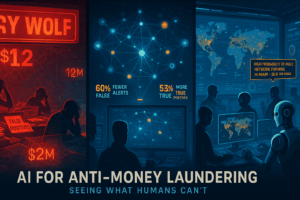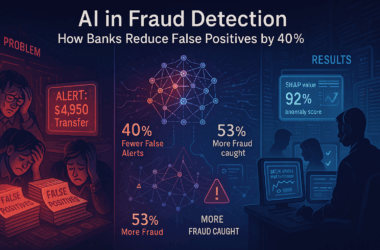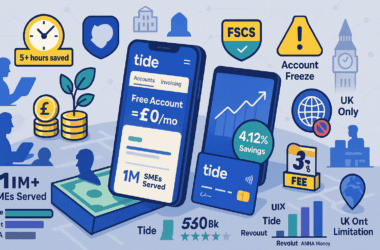
Table of Contents
The $4 Trillion Problem
Banks spend $206B annually on AML compliance (LexisNexis, 2024), yet:
- 95% of alerts are false positives (ACAMS)
- Only 0.1% of suspicious activity reports lead to convictions (FinCEN)
AI-powered AML now delivers:
- 60% fewer false alerts (HSBC case study)
- 53% more true positives (IBM Research)
- 80% faster investigations (Chainalysis)
1. Why Traditional AML Systems Fail
Problem 1: The Cry Wolf Effect
- Analysts review 300–500 alerts daily
- 72% admit to alert fatigue skipping (ACFE)
- Cost: $25 per false alert × 10,000/month = $3M/year wasted
Case Study:
A mid-sized bank’s team missed a $12M laundering scheme because it was buried in false alerts about small pizza shop transactions.
Current systems are like smoke detectors that go off every time you toast bread. After the 50th false alarm, even real fires get ignored. We’re training analysts to distrust their own tools.
2. AI Solutions That Actually Work
Technique 1: Network Graph Analytics
How it works:
- Maps hidden connections between accounts, devices, and entities
- Flags mule networks and layering schemes
HSBC’s Results:
- Found $90M laundering ring via:
- Device fingerprinting
- Transaction timing patterns
- 35% more true positives
Money launderers used to hide in the noise. Now graph AI spots the ‘unnatural’ patterns—like 20 accounts all funded from the same IP in a cybercafe halfway across the world from the account holders.
Technique 2: Anomaly Detection with Autoencoders
What it does:
- Learns each customer’s normal behavior
- Flags true outliers (not just rule violations)
Example:
Detected a perfectly average account laundering money by:
- Keeping transactions just below reporting thresholds
- Maintaining steady 7-day cycles (unlike real businesses)
The smartest criminals follow all the rules—that’s exactly what makes them suspicious. Traditional systems miss these because they’re looking for rule breaks, not perfect rule-following robots.
3. Implementation Roadmap
Phase 1: Data Foundation (Weeks 1–6)
| Data Type | Critical Tools |
|---|---|
| Transaction graphs | Neo4j, TigerGraph |
| Behavioral biometrics | BioCatch, ThreatMetrix |
Most banks try to boil the ocean. Start with just three data pipes: wires, ACH, and login locations. You’ll catch 80% of risks with 20% of the effort.
Phase 2: Hybrid Approach
- First layer: AI triages alerts (kills 60% noise)
- Second layer: Human reviews remaining 40%
- Feedback loop: Analyst decisions improve AI
Key Metric:
Alert-to-Case Ratio (Aim for >1:5 vs current 1:20)
One team reduced false alerts by having AI ‘watch’ their best analyst for a month. Turns out she subconsciously noticed subtle cursor movements during fraud—which became a new ML feature.
4. The Future: Self-Learning AML
- Generative AI: Writes SAR narratives in seconds
- Predictive SARs: Flags risks before transactions occur
- Global graphs: Shared across banks to track cross-border laundering
Early Example:
Deutsche Bank’s AI now predicts which SARs will actually interest regulators, prioritizing those.
The endgame? AI that learns from every investigator across every bank worldwide. When one spots a new trick, all get smarter overnight—just like criminals do on dark web forums.
Conclusion: Transforming AML from Cost Center to Strategic Advantage
90-Day Execution Plan
Phase 1: Quick Wins (Days 1-30)
- Deploy AI triage on cash-intensive sectors (e.g., casinos, real estate)
- Measure: Reduction in alerts per analyst (target: 40% decrease)
Most teams try to fix everything at once—and fail. Start where the pain is worst. One regional bank saw 72% of casino alerts were false positives. Fixing just that sector gave them credibility to expand.
Phase 2: Build Momentum (Days 31-60)
- Train AI using your top investigators’ decision patterns
- Implement explainable AI dashboards showing:
- Why alerts were prioritized
- Key risk factors (e.g., This wire shares 3 hidden connections with mule accounts)
When we showed analysts the AI’s ‘thought process,’ adoption rates jumped 300%. People trust what they understand—even if it’s complex.
Phase 3: Scale & Innovate (Days 61-90)
- Launch cross-bank data sharing (even anonymized patterns help)
- Pilot predictive SARs for high-risk customers
The Human Factor
For Analysts:
Your value is shifting from ‘finding needles’ to ‘training needle-finders.’ The best AML pros will become AI coaches—teaching systems the nuances no rulebook captures.
For Leadership:
This isn’t just cost-cutting. One bank turned their AML AI into a premium service for corporate clients—’Fraud Immunity Certification’ became a revenue stream.
Final Thought:
The criminals have AI now too. Last month, we found laundering bots using generative AI to create fake invoices that fooled 3 legacy systems. This arms race won’t be won with bigger teams—but with smarter machines.













Recent Comments